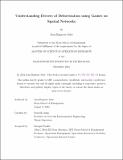Understanding Drivers of Deforestation using Games on Spatial Networks
Author(s)
Seby, Jean-Baptiste
DownloadThesis PDF (2.343Mb)
Advisor
Amin, Saurabh
Terms of use
Metadata
Show full item recordAbstract
As the impacts of climate change become more extensive and intense, effective actions for mitigation and adaptation become imminent. Since deforestation is a key driver of CO₂ emissions and forests constitute a crucial carbon sink, mitigating deforestation is an essential policy lever for governments. However, much of tropical deforestation results from actions of private entities that use the cleared land for activities such as palm oil tree cultivation, timber plantation, and agriculture. Often, the incentives to engage in (often illegal) deforestation within a forest concession are coupled with these activities and are also shaped by the activities in neighboring concessions. In this thesis, we focus on the problem of modeling these strategic interactions using game theory. We analyze a class of games in which agents engage in coupled activities over a spatial network and study a policy intervention to limit illegal deforestation.
Firstly, we conduct equilibrium analysis of a game in which each agent decides the production levels of her coupled activities in the presence of network effects. Practically, these network effects are induced by spatial arrangements of concessions and their ownership structures. We consider the general case where network effects are heterogeneous, i.e. network effects influencing palm oil tree cultivation and time logging are described by different graphs. We provide a sufficient condition for existence and uniqueness of Nash equilibrium. This result follows by leveraging potential function of the game or via a general variational inequality.
Secondly, we analyze how the spatial structure of concessions impacts the equilibrium outcome. In addition to the basic game in which each agent simultaneously engages in two activities, we consider a variation in which agents engage in one of the activities (but not both). We show that in both cases equilibrium structure can be expressed as a linear combination of weighted Bonacich centrality vectors -- a node-centrality measure that depends on the total number of walks that depart from a node (concession). Our analysis provides new insights on the drivers of illegal logging in forest regions where palm oil cultivation and timber logging are coupled.
Thirdly, we evaluate the impact of ``edge removal’’ intervention policy in which the boundary between two neighboring concessions is monitored or a buffer is created between them. We characterize the policy of a social planner who is interested in maximally reducing the illegal production of timber. Interestingly, we identify a regime shift (or phase transition) as the local network effect and level of coupling between activities vary. This result identifies conditions for which the social planner should incentivize specialization (enforce production of palm oil trees or timber) versus diversification (allow for both palm oil trees and timber) cultivation.
Date issued
2024-09Department
Massachusetts Institute of Technology. Operations Research CenterPublisher
Massachusetts Institute of Technology